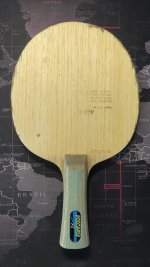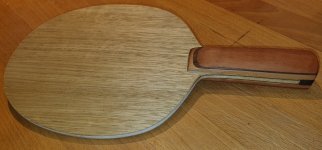Adding on to Nate's post...
I've found for templates I much prefer getting them laser cut to any other method. I currently use Ponoko in the US. There are probably Laser cutting services in Europe that you could use as well. This way I can trace patterns, size them precisely, and know that what I sized and drew is precisely what i will get, without any user errors in cutting/sanding which can cause imperfections along the edge of the template.
I have a router and router table, with numerous different router bits for my blade making. I have 2 different flush trim bits that I use for routing blades and trimming handles. One is Whiteside's amazing
Ultimate Combination Compression Trim Bit which is quite expensive, but produces extremely smooth edges. I use this on my blades. However it can be difficult to use with figured woods, so for handle trimming, and more fine detail trimming I use a smaller flush trim bit.
For Handles I use several different tools:
* For initial shaping of the handle I route them using the handle templates I have that go along with each individual blade template. I generally use the smaller flush trim bit for this, and pay careful attention to the wood grain, and route small bits at a time. Router tear-out on figured woods has destroyed a few handles right as i've been close to finishing them before, so i've learned to pay very close attention to grain as I route and this has been very beneficial.
* Once i've routed the template, I do some initial shaping with some hand planes. I've specifically found the
Lie Nielsen Low Angle Rabbit Block Plane to be indispensable for some of the handle work I do. It does a great job giving me a very smooth finish, as well as helping me ensure perfectly identical edges on two different pieces of wood before I glue them together when making a complicated handle.
* I use a
Freud Quadra-Cut Roundover Bit to round the edges on the handles. Quadra-Cut roundover bits use 4 blades instead of just 2, and really provides an exceptionally smooth finish. I do the rounding in very small increments to try to ensure i don't get any tearout, and pay close attention to the grain of the wood when doing rounding.
* Once all of this is done and I have the shape I want, then I use a sander to finish the process. A belt sander would be best, especially for producing the taper at the end of the handle where it meets the head of the blade. I use an orbital sander with 220, 320, 400 and 600 grit sandpaper to really fine tune to finish of the handles.
For Glues, I don't use PVA glue (Standard wood glue) Because of its water content and thus its potential to warp. I've been mostly using Polyurethane glue and Epoxy Resin (for carbon blades). I have found I quite like the feel of Polyurethane glue. I intend to start looking into Hide Glues soon though.
For clamping, I have a number of
Bessey 12" REVO Parallel Bar clamps that are awesome. I use these for combined with some pieces of sheet steel that i've covered with plastic wrap. I put the glued up wood in between the pieces of steel, and then clamp it. I've found this works great, and since i've coated the steel in plastic, there is no issue of any bleed through glue sticking the wood to the clamps or the steel.
I've also bought a number of things for safety purposes. I have a
hand corkscrew clamp that I use when i'm routing handles, to keep the router bit way away from my hands, given handles are small and even with a template, I don't want my hand inches from blades spinning at 10k+ rpm. I've also bought one of the
Micro Jig GRR-ipper which are amazing for routing as well. If i'm routing straight handles vs flared, I generally use the fence on my router, and the gripper to hold the handle piece and guide it down the fence, keeping my hands way away from the router bit.
One comment was made about wood and humidity controlled rooms. Wood definitely can take on moisture and that can affect weight. I'd taken to, after routing a blade, I will put it between two heavy pieces of wood, and place it in the oven at 185 degrees for a few hours. 185 degrees is just below the high end of the temperature range for PU glue, so the bond won't be affected, but you could lose a few grams in weight just due to moisture in the air. Keep in mind, if you do this, but then are in a humid environment, the blade will just take on water weight after a while anyways.
Hopefully this helps. MAking it a business I feel would be quite challenging. I've sold several blades so far, but doing it by hand is time consuming, and i'd prefer to spend the time making something beautiful...to me the craftmanship and uniqueness of custom made blades (making things that no one else has made, with combinations of woods that aren't used by manufacturers, etc) is a lot of the fun with blade making. Given I have a full time job, its just a hobby for me, but one i've invested considerable money in.
Chris













